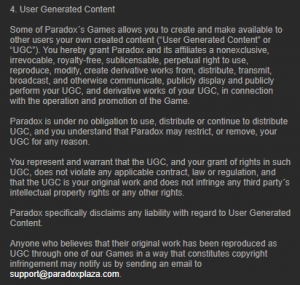User generated content (UGC) can provide a company with a lot of positives, marketing and community-wise, but it comes with a ton of legal landmines. When managing a VR/AR experience, here are some things to keep in mind if a developer is going to allow UGC.
The primary legal issues
The two main legal issues with UGC are the possibility that the content is a potential infringement on other people’s rights and that the content may make the developer of publisher liable for the action of users.
In the US and the US only, a developer or publisher can avoid liability for each of these through statutory safe harbors.
A purveyor of a VR/AR experience can avoid liability for user copyright infringement by complying with the requirements of the Digital Millennium Copyright Act’s safe harbor provisions. This includes having a DMCA compliant notice and take-down policy and a repeat infringer policy established for the experience.
To avoid liability for the things that people do (most specifically libel), the purveyor needs to follow the safe harbor requirements of the Communications Decency Act (CDA). The CDA requires that service providers not be editorial and avoid curating content. If a provider gets too involved editorially, it can be held liable. But if the provider lets things come in and doesn’t really look at the content, it would not be liable for that content. The irony of this is that it often leads platforms to allow more content that is likely problematic to avoid being seen as too heavy handed in their curation.
It’s an odd system but this is how it works currently in the US.
Who owns the content?
When content is submitted to a VR/AR experience, website, or any other platform – by default, the person who makes the UGC owns the content. Usually a EULA or Terms of Service can’t change that or require a transfer of ownership (since without a signature that transfer would be difficult to enforce).
However, a EULA or Terms of Service does typically include some semblance of a license to the work. That content essentially becomes licensed by the platform and the platform has broad rights to act as if they might own it.
To the right is an example of Paradox’s UGC policy and when UGC is submitted, “You hereby grant Paradox and its affiliates a nonexclusive, irrevocable, royalty-free, sublicensable, perpetual right to use, reproduce, modify, create derivative works from, distribute, transmit, broadcast, and otherwise communicate, publicly display and publicly perform your UGC, and derivative works of your UGC, in connection with the operation and promotion of the Game.”
How to address it in the EULA
The primary takeaway is that the developer or publisher should typically address the handling of UGC in the EULA.
The EULA needs to address ownership and licensing of UGC. For example, while users are likely to continue to own the content, the company probably needs a license to the content in order to provide that user with the service they are expecting. The company may also want additional permissions, like the right to use the UGC in advertising. The EULA should require the creator to represent and warrant to the company that the user has the rights to put the content on the service in the first place, and indemnify the company for breaches of that warranty.
Beyond ownership and licensing, company should also be expressly allowed to take down the content at any moment for any reason. Another example (presented without comment, criticism or endorsement) is Nexon’s UGC policy. In that policy, Nexon reserves the right to remove content. It also specifically includes a reference back to its repeat infringer rules (see above).
The EULA should also require the users represent and warrant that their content is not libellous and does not violate the law. It should make clear that users are responsible for their own content, and disclaim any responsibility for user-to-user interactions. This all goes to the CDA safe harbor. However, the company might also want to have a clear acceptable use policy setting forth broad categories of content that will not be permitted. Again, this should include an indemnification.
Company’s should be careful not to rely too heavily on the indemnification provisions in these agreements, though. As with any indemnification provision, if it turns out that the user is called upon to indemnify the company, but the user has no money, the indemnification provision is basically useless.
View all posts by this author
